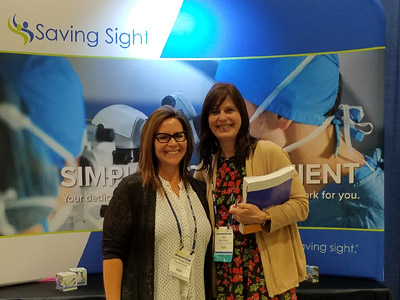
Lynn Forest-Smith, Director of Business Development at Saving Sight, with Dr. Jody Summers at ARVO 2019 in Vancouver.
Kansas City, Mo., August 21, 2019 – Jody Summers, PhD, professor of cell biology at the University of Oklahoma Health Sciences Center, studies the extracellular matrix of the sclera and changes associated with myopia development. Myopia is largely regulated by the visual environment. Through her studies, she hopes to understand why myopia interacts the way it does so intervention is possible.
“Nearly 50 percent of the world’s population will be myopic by 2050,” says Dr. Summers. “In some countries, such as those in East Asia, myopia is the leading cause of blindness. It can be completely preventable with how the eye responds to the visual environment if we can learn why.”
As a postdoctoral fellow in ophthalmology, Dr. Summers identified that there was little research with regard to the sclera. “Through research, I discovered that the sclera is not just a static container in the eye. The sclera is actually very active and can alter its compositions to control the refractive state or length of the eye. What happens in myopia is the sclera begins to elongate. Because sclera is a very responsive tissue, we are trying to understand how sclera remodeling happens so we can work to regulate it – which has taken us to this study.”
Saving Sight was honored to be a co-author on a research project at the 2017 Annual Meeting of the Association for Research in Vision and Ophthalmology (ARVO) with Dr. Summers, titled Isolation and Transcriptome Analyses of Choroidal Retinaldehyde Dehydrogenase-2 (RALDH2) Expressing Cells.
At ARVO 2017, Dr. Summers successfully isolated cells in the choroid (the vascular layer of the eye, located between the sclera and the retina) of both chick and human eyes which have been found to produce the enzyme retinaldehyde dehydrogenase 2 (RALDH2).
“The ARVO abstract was preliminary research to see if we could isolate those cells,” says Dr. Summers. “We first had a pilot study where Saving Sight provided us with two, reduced fee whole globes. This showed we could isolate the retinoic acid in the choroid.”
In summer 2019, Dr. Summers received National Eye Institute at NIH funding to further study the isolated cells through transcriptome analyses. Part of that grant contributes to the fees associated with receiving 10 whole globes or poles (which is the whole eye minus the cornea) from Saving Sight. “This next step is to do it again and do the transcriptome analyses to identify the cells in the choroid that make the retinoic acid.”
Dr. Summers adds that retinoic acid is a powerful chemical and they are interested in identifying the cells that produce it. “If we identify these cell types we can, perhaps, use that information to develop strategy to control the synthesis of retinoic acid,” she says.
Since the human genome has been sequenced, Dr. Summers will be able to sequence the cells from the choroid and compare with the human genome sequence to gather more information as to which cell type is responsible for retinoic acid synthesis.
Collaboration between Researchers and Eye Banks
“I value working with Saving Sight because it was very easy to get the collaboration set up,” says Dr. Summers. “I love that they are interested in research and feel like it’s a two-way relationship. I’m really glad they are available and willing to introduce a new technique or procedure that is compatible for research.”
Dr. Summers adds that one of most valuable connections in eye banks and researchers working together is the ability for Saving Sight to provide human eye tissue for research. “NIH funded research hopes to help humans through the betterment of health. Being able to provide tissue like Saving Sight does under the conditions needed is of value because not many eye banks do that.”
About Saving Sight
Saving Sight is a nonprofit eye bank with a mission to change lives by saving sight. Founded in 1960, Saving Sight has grown to become one of the nation’s leading eye banks and is focused on providing innovative solutions to its clinical and research partners. Saving Sight welcomes customized research collaborations that meet your research tissue needs and strives to advance the field of corneal transplantation through dynamic collaborations with medical centers and researchers. Headquartered in Kansas City, Mo., Saving Sight facilitates eye donation in Missouri, Kansas, and Illinois, serving transplantation and research specialists locally and around the world.
Click here to learn more about Saving Sight’s customized research collaborations.

